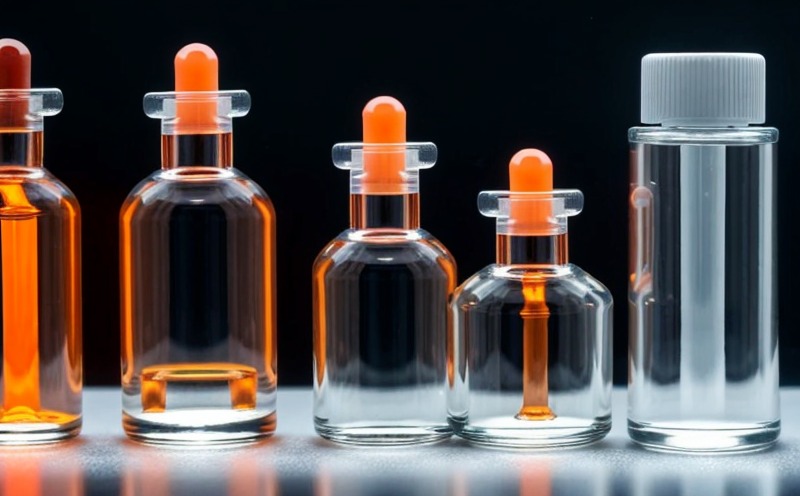DIN EN ISO 13365 Dermal Absorption of Nanomaterials for Safety Evaluation
The DIN EN ISO 13365 standard provides a comprehensive framework for the dermal absorption testing of nanomaterials, designed to assess their potential impact on human health and safety. This stringent procedure ensures that materials used in various industries are evaluated accurately against international standards.
Understanding nanotoxicology is crucial as it pertains to the behavior, effects, and transport of nanoparticles when they interact with biological systems. The DIN EN ISO 13365 standard specifically addresses dermal absorption, a critical pathway for nanoparticle entry into the human body. This testing method helps identify potential risks associated with skin contact, thereby supporting informed decision-making in product development.
The methodology outlined in this standard is essential for ensuring that nanomaterials comply with safety regulations before they are introduced to the market or used in industrial processes. By adhering to these stringent guidelines, manufacturers can mitigate any adverse effects on human health and the environment.
One of the primary focuses of DIN EN ISO 13365 is the evaluation of nanomaterials through dermal exposure scenarios. This involves simulating real-world conditions where nanoparticles may come into contact with skin, such as during production, handling, or use. The standard provides detailed protocols for preparing samples and conducting tests to measure the amount of material absorbed through the skin.
Another key aspect is the selection of appropriate test substances and systems. This includes choosing suitable nanomaterials that represent those most likely to be encountered in actual applications. Additionally, it involves selecting appropriate animal models or alternative testing methods that accurately reflect human physiology while adhering to ethical standards.
The DIN EN ISO 13365 standard also emphasizes the importance of reproducibility and reliability in test results. To achieve this goal, strict quality control measures are implemented throughout the entire testing process. These include precise sample preparation techniques, standardized procedures for conducting tests under consistent environmental conditions, and rigorous calibration of analytical instruments used to quantify nanoparticle concentrations.
Moreover, the standard addresses challenges related to nanoparticle characterization. Accurate identification and quantification of nanoparticles are essential steps in assessing their dermal absorption properties effectively. Advanced analytical tools such as transmission electron microscopy (TEM) or dynamic light scattering (DLS) can provide valuable information about particle size distribution, shape, and aggregation state.
Another critical challenge addressed by DIN EN ISO 13365 is the variability of skin responses among individuals due to factors like age, gender, genetics, and pre-existing conditions. Understanding these variations helps researchers design more accurate predictive models for estimating nanoparticle concentrations in different parts of the body after dermal exposure.
Furthermore, the standard encourages collaboration between laboratories involved in nanotoxicological research across borders. Such cooperation fosters knowledge sharing and harmonization efforts aimed at improving global standards for assessing nanomaterial safety.
In summary, DIN EN ISO 13365 plays a vital role in promoting responsible use of nanotechnology by providing robust methods for evaluating dermal absorption risks associated with various types of nanoparticles. Compliance with this international standard ensures that manufacturers and users alike are aware of potential hazards posed by these materials early on in the product lifecycle.
Scope and Methodology
The DIN EN ISO 13365 standard applies to nanomaterials intended for use in consumer products, industrial processes, or other applications where dermal contact is possible. It specifically aims to assess the extent of nanoparticle absorption through intact skin using standardized test methods.
| Parameter | Description |
|---|---|
| Test Substance Selection | Select nanomaterials representative of those most likely to be encountered in real-world scenarios. |
| Skin Preparation | Cleanse and condition test subjects' skin according to specified protocols. |
| Dermal Exposure Conditions | Simulate realistic exposure conditions by applying nanoparticle solutions topically for defined periods. |
| Sampling Techniques | Harvest samples from the applied area at predetermined intervals post-exposure. |
| Analytical Methods | Use advanced analytical techniques like TEM or DLS to quantify nanoparticle concentrations in harvested samples. |
The methodology described above ensures consistency and accuracy in evaluating dermal absorption rates of nanomaterials. By following these procedures meticulously, laboratories can generate reliable data that contribute to informed decision-making regarding the safety of nanotechnology products.
International Acceptance and Recognition
- DIN EN ISO 13365 has gained widespread recognition among regulatory bodies worldwide due to its rigorous approach to assessing dermal absorption risks associated with nanomaterials.
- The standard is widely accepted in Europe, North America, Asia-Pacific regions, and other parts of the globe where stringent safety regulations apply.
- Many countries have adopted DIN EN ISO 13365 as part of their national standards or guidelines for evaluating nano-based products before market release.
- A number of international organizations including WHO, OECD, EPA, and others recommend compliance with this standard to ensure consistent evaluation practices globally.
Compliance with DIN EN ISO 13365 not only enhances the credibility of testing results but also facilitates smoother trade between countries by ensuring uniformity in regulatory requirements for nanomaterials.
Use Cases and Application Examples
| Application | Description |
|---|---|
| Personal Care Products | Evaluating dermal absorption of nanoparticles used in cosmetics, sunscreens, etc. |
| Medical Devices | Assessing the safety of nanomaterials incorporated into medical devices like bandages or prosthetics. |
| Consumer Electronics | Determining whether nanoparticles in electronic components pose dermal hazards during manufacturing processes. |
| Environmental Monitoring | Identifying potential exposure routes for workers handling nanomaterials in hazardous environments. |
In each of these applications, DIN EN ISO 13365 provides a standardized approach to evaluating dermal absorption risks associated with nanoparticles. This ensures that manufacturers and researchers can make informed decisions about the safety of their products early on in the development process.





